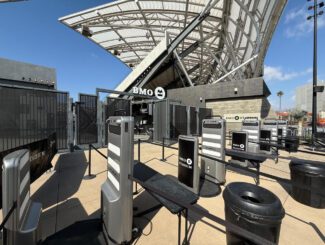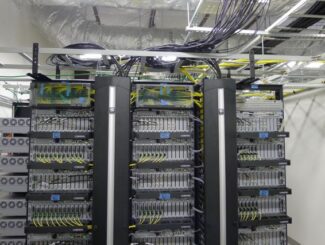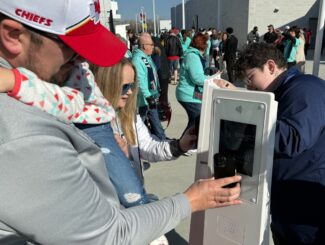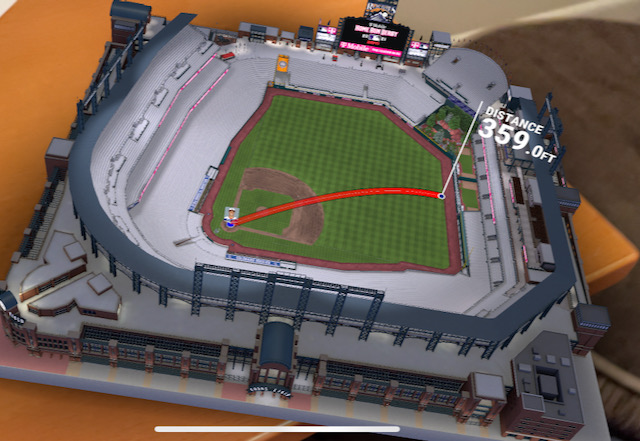
Like a hot prospect who shows lots of promise, the T-Mobile / MLB AR app put out for this year’s Home Run Derby had some exciting flashes of talent but in the end it just wasn’t good enough to make the big-league roster.
Here at Stadium Tech Report we were excited to see the app in action, since we’ve been kind of hungering to see something in stadium/event apps that went beyond multiple-camera replays that usually take too long to call up. The press release sent to us by T-Mobile had all kinds of exciting promises, like watching the dingers in 3D augmented reality on your phone, with instant stats like launch angles and distance that would theoretically bring a new edge to a show that can get kind of repetitive.
We also thought that the touted “5G connected” cameras mounted on players’ hats and catchers’ masks were going to provide some cool additional views to the app, but alas when we wrote our initial story we didn’t read the fine print. Yes there were 5G connected cameras, but according to a T-Mobile spokesperson who emailed us during the event (when we asked where the video was), the press release never said there would be 5G video in the app — it was for the broadcast video of batting practice and some views that would “show up sporadically” in the live TV coverage of the event.
Now I did watch the captivating first round of the event on TV when Juan Soto upset the favorite Shohei Ohtani in overtime — and I don’t remember seeing even one POV look. I didn’t watch any more of the broadcast, so if there were “sporadic” views I’ll have to take T-Mobile’s word for it. As for “batting practice” — I mean, who watches TV coverage of batting practice for the Home Run Derby? That’s like eating a plate of cookies just before your birthday cake comes out of the oven. To me, that likely expensive temporary 5G network T-Mobile brought in to Coors Field to support this effort (T-Mobile declined to reveal the exact cost of the deployment) seemed to be a waste if you couldn’t put that POV video into the app. But that was just one of too-many disappointing aspects of an otherwise interesting and laudable effort.
Installing and operating harder than hitting a curve ball
Beyond not having POV video, my biggest beef with the app was its setup and operation — if, like me, you had never used an AR app before, it was a puzzling leap-of-faith kind of operation, with only the shortest amount of instruction beforehand. I had installed the app last week to give it a test run and thought I had it figured out (there is a step where you have to hold your phone over a “smooth surface” to initiate the AR, but the process can last endlessly without any indication if you are doing it correctly or not). But when I opened the app I’d installed last week after the opening round, it was showing a screen saying the contest wouldn’t start for three-plus hours, and then it froze my screen.
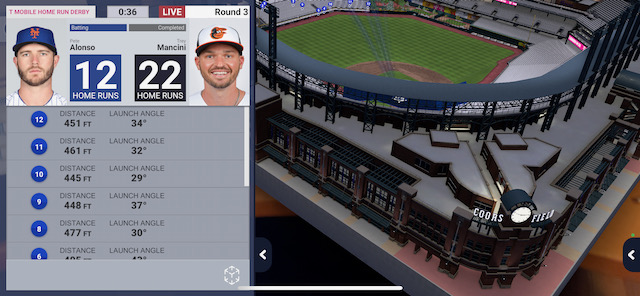
Turning off the phone twice didn’t help, so I went for the iPhone equivalent of CTRL-ALT-DELETE, deleting the app and re-installing a new version. Bingo. After about a minute of waving my phone around my desk, Coors Field was suddenly there on my screen, right next to all the other junk on my desk. If there was anything supremely impressive about the app, it was the captivating rendering of the field and the fun little T-Mobile blimp that kept circling around.
As promised, the app did hit it out of the park when it came to showing the live 3D rendering of dingers, a cool feature that could have been a real additive to the TV broadcast, which (as always) had a hard time keeping up with the rapid-fire delivery of home runs being hit. But I wasn’t in the room where the TV was, so I was stuck with only the app to follow the action — and while the live dinger-tracking was informative (it was similar to what PGA broadcasts have now for some shots, where they are traced during their flight), the only sound from the app was a simulated “crack of the bat” that made me think of Bull Durham and the radio guy whacking a stick during his studio broadcasts to simulate live action. It felt like watching Gamecast, which is fine in a pinch but not the kind of performance you wanted for a big-stage app like this one.
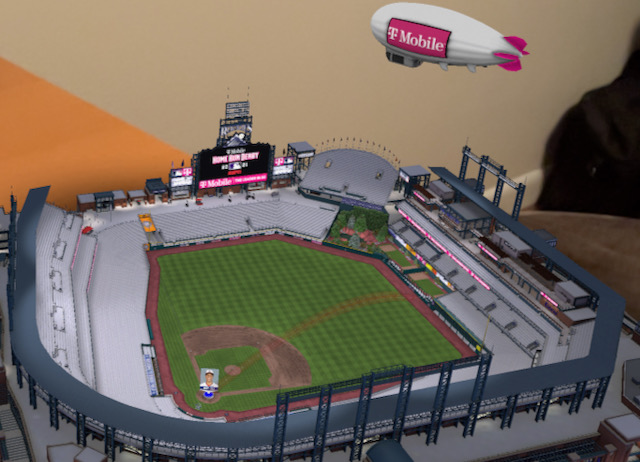
Top suggestions for improving the app from my end include importing the play-by-play voiceover, which would have the added bonus of letting you know how much time was left in each round — to find that out on the app you had to click on a side screen, and as with many parts of the app it was hit or miss if the stats you wanted were live or accurate. At one point the app was showing Soto winning brackets he wasn’t even entered in, and several times the scoring part of the app just froze. The stats part also didn’t note when players were taking a break so you had to basically sit there and watch a still phone not knowing if the app was still working or not. I also had to do the delete-reinstall dance one more time after closing the app and it wouldn’t open a second time.
And yes, if you’re going to have player point-of-view cameras that use cool new 5G-capable chips to relay the action, why on earth would you leave that out of your app when ostensibly you want to promote phone activity if you are a cellular carrier? To me that was a big swing and a miss. With any luck we’ll see improvement from this rookie app since the canned press-release quote from T-Mobile CEO Mike Sievert promises that there will be future versions of the app and “It’s going to be epic, and this is only the beginning!” If the kid can work on his video access and improve his interface, maybe we can call him up in September before the playoffs.



